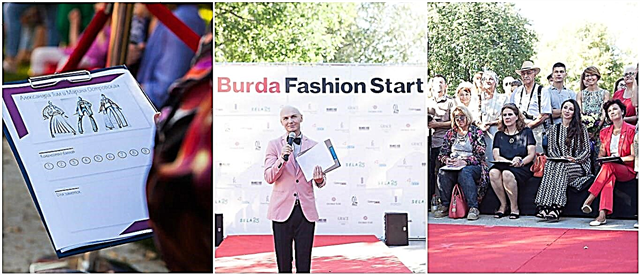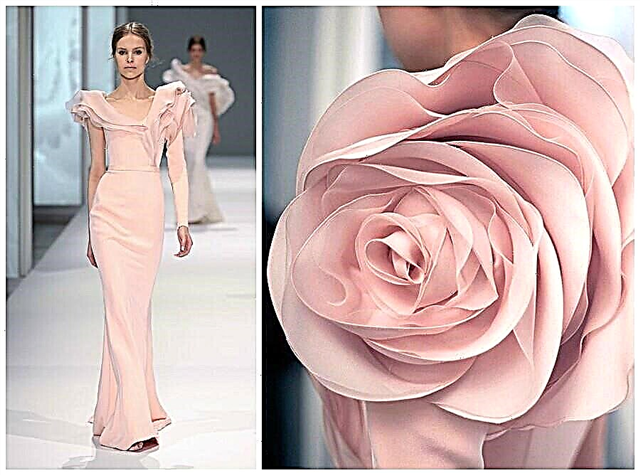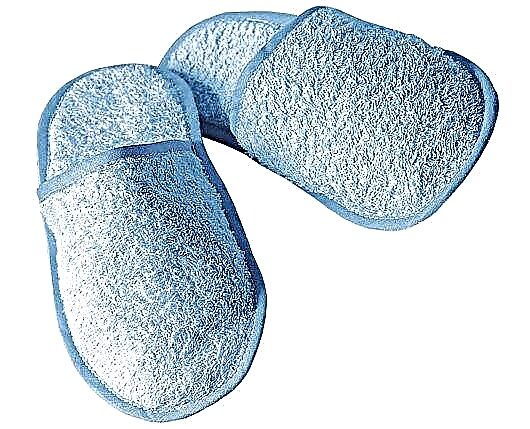The collar of a strict shirt should be tight with additional inserts, the so-called "bones", providing a clear form. We will consider the processing of the collar with these elements.

Bones ("collar bones", "collar stays") are glued, and then they cannot be removed from the collar and replaced in case of breakage.
In the collars of shirts of the premium segment, they put bones in special pockets - drawstring. The bones are plastic, metal and nacreous.
In the first part of the master class, we examined different forms of the collar, examined how to adapt the pattern of the collar, prepared the pattern of the backstage for the bones:
Processing the collar of a man's shirt: choosing a shape and preparing a pattern
In the second part of the master class, we will consider processing the backstage for the bones in two ways, we will process the collar and stitch it in the neck.
Step 1
1 option drawstring

Reveal the details of the collar and stand: part of the upper collar, part of the lower collar, two parts of the clearance and two parts of the stand. The direction of the warp thread is along the collar and stand. If there is a clearly defined pattern on the fabric, it must be combined along the seam of the collar and the stitch. In addition, the pattern should be located symmetrically with respect to the center of the collar and stand.
On the lower collar and the gap, the pattern should also be combined.
Note: the details of the lower collar, the outer and inner racks can be cut out from 2 parts with a seam in the middle.
Processing allowances:
- along the sections of the collar - 1.0 cm,
- by cutting the rack in the neck - 1.5 -2.0 cm,
- along the top cut of the rack - 1.0 cm.
Put center marks on all parts of the collar and stand.

Cut parts from duplicate gasket:
1) two parts of the collar (according to the pattern of the upper collar) without allowances at the ends and departure of the collar. The allowance for the cut of the stitching to the stand is 0.7-1.0 cm. The gasket detail for the upper collar at the ends of the collar departure is 2 mm longer on each side. This is a necessary allowance for the formation of the landing and sweeping transition edge.
2) two parts of a rack without allowances.
Put center marks on all the details of the collar and rack.
2 option drawstring

Cut into two parts of the collar, stand and clearances. Allowances for cutting are the same as in the first method.
Note:
I will additionally perform the edging of the inner stand of the collar with an oblique edging, so I cut out the internal part of the stand without allowance for the stitching into the neck. And she additionally carved a strip for oblique inlay from a finishing fabric at an angle of 45 degrees to the warp. The width of the strip is 3.0 cm, the length is the length of the rack + 2.0 cm.

Cut parts from the backup gasket as described above.
Step 2
Handling the scenes in the first way:

Place the detail of the lower collar on the ironing table with the wrong side up. Unscrew the one-piece allowance along the bottom line of the drawstring to the wrong side and iron it.
Place the lower collar on the details of the clearances along the alignment line. Mark the drawstring with a chalk or marker. Sew stitches along one side of the drawstring and fold, then along the second side of the drawstring and fold.

This processing method is simple to implement, but has one small drawback - there is a difference in height at the ends of the collar due to additional layers of fabric in the place of the drawstring. However, this is the method I most often use.
Processing the scenes in the second way:

Mark the bottom line of the drawstring on the collar details with a marker, chalk, or using copy stitches.Make an incision to the lower corner of the drawstring, not reaching the marking of 1-2 mm.

Place the collar part on the clearance by bending the allowances along the lower line of the drawstring to the marking. Mark with drawstring chalk or marker.

Lay the stitches on one side of the drawstring and bend, then on the second side of the drawstring, in addition to the notch, put the machine bartack. Processing the wings in this way requires special care, in addition, it is not suitable for loose fabrics (for example, like the jacquard that I use in the first example), because the allowance along the lower edge of the drawstring is minimal, and the inner cut is not processed in any way. Nevertheless, this method is widely used and has proved to be good on fabrics with tight weave fibers.
Processing sleeves in a man’s shirt using Italian technology: sleeve slit
Step 3

Place the gasket parts on the collar and stand parts, aligning the middle marks.
Important!
We duplicate the lower collar after processing the drawstring (we use the part of the gasket that was cut out without allowance of 2 mm at the ends of the collar). When duplicating collars made of fabrics with a pronounced pattern, we pay special attention to the correct location of the gasket: the same pattern repeat should be placed symmetrically at the ends of the collar departure, longitudinal stripes (if any) should be parallel to the collar departure.

The details of the collar with rounded ends can be duplicated in the same way, with the exception of the inner stand - it is cut without any sewing allowance, since it will be edged with an oblique trim.
Step 4

Iron the bottom allowance on the inside of the rack to the wrong side. Fix a line at a distance of 1.0-1.5 cm from the bend.
An alternative way of processing an oblique collar with one open cut:

To put a slanting inlay on the inner part of the rack with their sides facing each other. Sew on a width of 0.5-0.7 cm from the edge.

Iron the seam allowance for the seam on the tape. Bend around the slice of the rack, sweep the edging with oblique stitches.

Iron. Fix the piping with a stitch exactly in the seam of the sewing.
WTO Secrets: What does it mean to iron?
Step 5

To equip the allowances for the departure of the collar. Fold the collar details with the sides facing inward, aligning the center marks. Chip off the parts, clearly aligning the edges of the gaskets on the upper and lower collars. Form a small fit at the corners of the collar.
Sweep the parts with straight basting stitches, departing from the edge of the pad 0.1 cm so that the basting stitch does not fall into the seam of the collar turning.

Stitch the collar fit 1.0 cm from the cut.

The collar is prepared for turning.
Step 6


Sharpen the collar from the bottom of the collar clearly along the edge of the gasket. When a dense collar adhesive gasket gets into the seam, it prevents the straightening of the seam from turning the collar and the formation of a clear edge at the ends and out.
When laying a seam in the corners, it is necessary to "blunt" the corner with one or two stitches across - this helps to invert and form a sharp corner.

To iron a seam of a turning of a collar. Carve a seam allowance in the corners: first cut the corner, not reaching the line 1-2 mm, then carve an allowance in the corner at the take-off and the ends of the collar.

Cut off the drawstring allowances close to the seam of the turning, leaving the allowances for the lower collar. Put oblique notches on the curves.
Step 7

Unscrew the collar on the front side, straighten the corners with a peg. Knit the edging from the upper collar with oblique stitches, iron. Lay the finishing stitch.

Set up the collar allowance for the lower cut. To do this, bend it across in half, check the symmetry of its ends and the conformity to the pattern, leave an allowance at the seam of the sewing to the rack 1-1.2 cm.
Then bend the collar along the top collar up. Secure the fold with clamps. On the edge, connect the two collars together, without removing the clamps.This will form a slack on the upper collar, necessary to bend around the lower collar, so that during operation there is no influx of excess tissue from the side of the lower collar.
Step 8


To equip the allowances of the outer and inner struts along the seam of the stitching to the collar. Draw the inner stand on the front of the collar, aligning the center marks. Fold the collar with the stand in half, align the ends, check the symmetry of the ends of the collar and stand. Lay the stitch from the stand side only in the collar area, exactly along the edge of the adhesive strip.

Fold the parts of the inner and outer racks together with their faces inward, align the center marks and the ends of the racks. Chop or sweep. Start rack parts on the inner rack, laying the seam exactly to the previous one.

At the ends of the strut, do not tap 1–2 mm to the stitching line in the neck. Similarly, handle the rack with the edged inner cut.

Carve allowances on the curves, put notches, not reaching the stitch by 1-2 mm. Iron the seam allowances on the stand on one and the other side of the collar. Turn out, iron. Fix the allowance with a stitch 0.1-0.2 cm from the seam only in the collar area.

Mark along the fold of the inner pillar. To equip the allowance for the seam of attaching the stand to a width of 1.0 cm from the marking.

The collar is ready to be sewn into the neck.
Neapolitan cuffs and openings armhole in a man’s shirt
Step 9


Place the collar with the stand on the front side of the shirt, align the center and middle marks of the back, the edges of the stand and the edges of the sides. Sweep or stick the collar into the neck.

Embroider the collar with a seam 1.0-1.2 cm wide, lay a stitch 1-2 mm from the markings on the stand, so that later this seam overlaps the edge of the inner stand.
Iron the seam allowance on the rack. Carve allowances in the corners of the rack, not reaching the seam 3-4 mm. The neckline allowance should be cut at an angle to the seam, not reaching 3-4 mm to the seam.
Step 10

To sweep the inside of the rack, overlapping the sewing in by 0.1 cm.

Stitch the inner pillar 0.1 cm from the fold. Lay the finishing stitch at the ends of the stand and along the collar.


Similarly, grind the inner rack with the edged cut.
How to properly carry out wet-heat treatment of men's trousers
The author of the master class and photo: Elena Lenkova

Lena has a higher and special education - a tailor of outerwear for men, women and children.
In clothes, he appreciates the individuality and thoughtfulness of the image, the originality of the cut. He likes to analyze modeling techniques and product processing technology. Leads his page on Instagram. Many people know Lena as a longtime user of the BurdaStyle.ru website.
"The quality of processing and the interior decoration of the product are integral aspects of sewing."
Material prepared by Julia Dekanova



